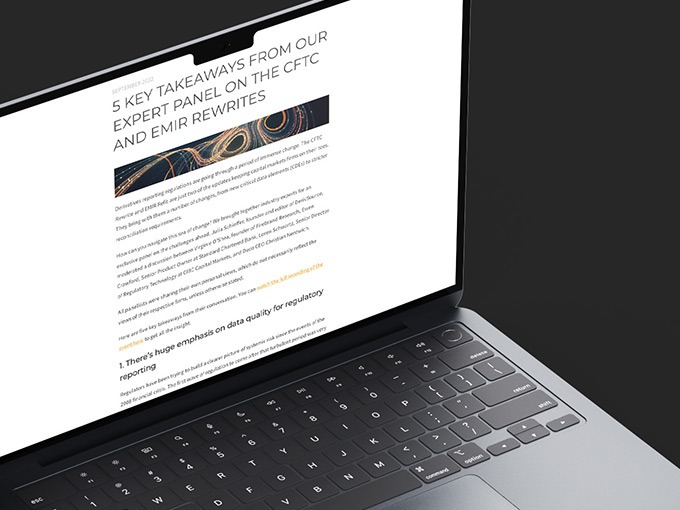CFTC and EMIR reporting:
Getting it done right webinar
The latest push for data quality from ESMA raises questions over how financial firms deal with change. Technological innovation has enabled an agile new approach – but how do you embrace this?
Discover new strategies to tackle regulatory reporting with the latest insights from industry experts and technology leaders.
CFTC and EMIR reporting rewrites: Getting it done, getting it right for the future
We brought together industry experts from Standard Chartered, CIBC, Firebrand Research and DerivSource to discuss regulatory reporting. Hear their views on how firms can meet the challenges of the EMIR Refit.
Watch: The top reporting challenges from the EMIR Refit
Firebrand Research founder Virginie O’Shea explains the main challenges of the EMIR Refit and how to prepare.
Top industry commentary on the EMIR Refit
The seven day notification is a very significant challenge. Fine, if you’re sending 10 swaps a day and one is wrong. If you’re sending 100,000 or 2 million or 10 million messages a day, and quality assurance tells you you’ve got error sets across 5% of it […] That whole operation of the notification process becomes extremely challenging.”
While regulators are trying to converge on the data and the changes, they’re also making a number of the changes in lockstep with one another. Because there is some variation, the challenge becomes a resourcing challenge, because very often the same subject matter experts across the organisation and across the architecture are dealing with these changes.”
We’ve had Brexit since EMIR’s been implemented, which means that there could be some divergence between the EU and the UK regimes. Given that the UK market is one of the largest derivatives markets in the world, the UK may, in the coming months, decide that it wants to change tack. These things do happen when you have politics in the mix.”
We see a lot of exciting developments out there on automatically mapping things with machine learning, on rethinking how the subject matter experts can be involved in these projects at a very technical level, but without having to create technical projects unnecessarily. These things are always very compelling events to revisit architectures and so on.”
One-size-fits-all does not fit in this environment. People that think “oh, I’ve got a very robust cash-management reconciliation solution that’s going to be able to work for derivatives” are going to get a big shock and surprise. There’s nothing like a complex swap to break everybody’s brains and processes at the same time.”
These are personal views and do not necessarily represent the views of the individual’s firm.
Unlock the power of your data with Duco
Fill in the form to watch an extended demo of the Duco Platform in action.



